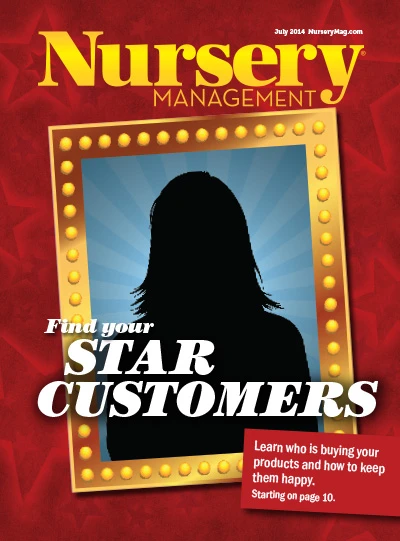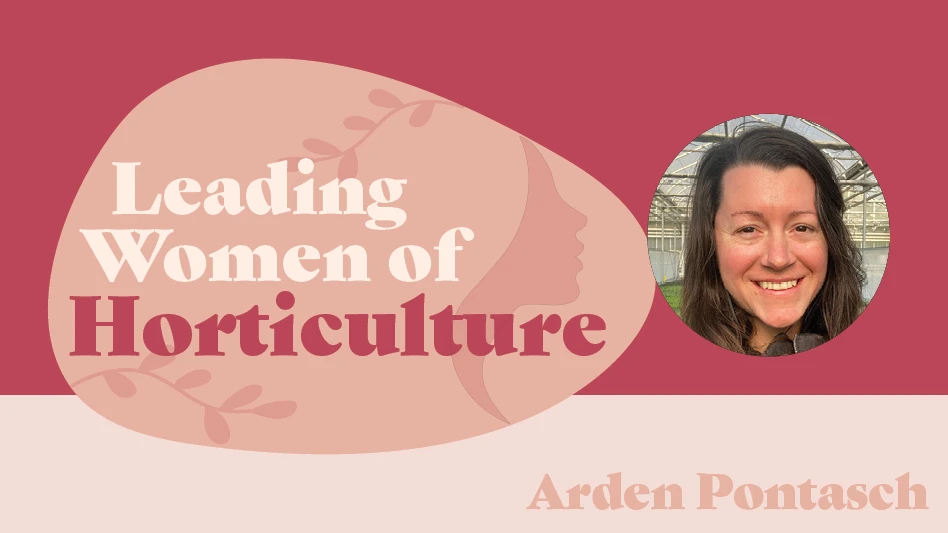
 You’ve been in this business for a while, and you know your customers. You know their preferences when it comes to boxwood or hydrangea or which maple cultivars they like. Maybe you even know what kind of car they drive or what sports their kids play. But what about the final consumer? If your nursery has a retail element, you are directly involved with the end consumer. But understanding the consumer is important for wholesale nurseries that are a few steps removed from the homeowner planting that shrub or tree in their yard.
You’ve been in this business for a while, and you know your customers. You know their preferences when it comes to boxwood or hydrangea or which maple cultivars they like. Maybe you even know what kind of car they drive or what sports their kids play. But what about the final consumer? If your nursery has a retail element, you are directly involved with the end consumer. But understanding the consumer is important for wholesale nurseries that are a few steps removed from the homeowner planting that shrub or tree in their yard.
Who is the customer?
The customer in this case is the final consumer – the person who walks into a retail garden center to purchase plant material, or engages a professional company to design and install a landscape for them. John Ball, a professor with South Dakota State University’s Plant Science department and forestry specialist with the SDSU extension, says this customer may not be who you expect.
“The person we really need to talk with is a woman, not a man,” Ball says. “Essentially, a late Baby Boomer, a person who has a college education, an upper household income. Most of the kids have left, maybe one is still coming back. That person in our market is the person who buys most of the plant material that is being sold and installed, one way or another, in residential landscapes.”
This prototypical customer is too often ignored, Ball says, for a variety of reasons. First, if the customer is approaching a landscape company, a design/build salesperson is usually male and tends to focus on the male part of the couple. At a garden center, though there is a smaller gender disparity in the sales force, the salesperson still tends to talk to the man. Ball stresses that this habit needs to be broken.
“One way to look at it is when selling plant materials, the man is window dressing,” he says. “He is not going to have much impact as to what is being purchased. We need to focus on what she wants and what her interests are.”
There is a reason that Ball said that customer is the person you need to “talk with” –not “talk to.” The particular phrasing is a reminder that this person is an educated consumer with opinions, interests, likes and dislikes. This is someone who does not like being dictated to, so salespeople need to listen to them, find out what they are looking for and then provide them with some options.
Offer something unique
So what does the customer want? Contrary to what many believe, they don’t want the standard, boilerplate choices. “They do not want a cookie-cutter landscape,” Ball says.
“They do not want to just plant what their neighbors have. They want something that is unique that says something about them as well. To me, that is a real plus.”
The desire for something unique and exciting presents an opportunity for the savvy grower. While a big-box retailer can sell plant materials for less than a grower-retailer or IGC, that big-box store won’t have the variety that a smaller store can provide.
 For growers, this means that in addition to providing the standards to your retailer customers, consider adding something different to your product line that savvy shoppers won’t be able to find elsewhere.
For growers, this means that in addition to providing the standards to your retailer customers, consider adding something different to your product line that savvy shoppers won’t be able to find elsewhere.
“You need to carry and provide the meat and potato plants, the ones that are common to almost every landscape for a reason, but everyone wants their own signature,” Ball says.
These “blind plants” are incredibly valuable to garden centers, because of the competitive edge they provide. If your competition doesn’t carry that particular item, that allows you to set its price.
Of course, it’s still important to provide the old standbys – plants that are well adapted to a particular climate and soil, with years of proven results and a sterling track record – because plenty of customers need them, especially if selling to landscape contractors is a big part of your business.
The power of choice
Consumers like choices, not only when it comes to the varieties of plants available, but the sizes, as well.
“Everyone in the industry knows how disappointed someone can be when they go home and plant that No. 2 plant in their yard and it looks so tiny,” Ball says. “The No. 3s, No. 5s, even No. 7 container shrubs are not going to match the size of a mature landscape, but it certainly has more curb appeal than that No. 1 or 2 container plant.”
Ball suggests growers offer more choices of containers sizes, based on price and the customer’s willingness to wait for the plant to grow.
Willoway Nurseries, a northeast Ohio-based wholesale grower, offers a large variety of items in various sizes. Danny Gouge, Willoway’s marketing manager, says the nursery offers different price points for retail and landscape trades. Retail consumers are more price-conscious and willing to shop around, he says, but LCO customers are often looking for something specific right away and willing to pay a premium for that convenience.
“As we plan our inventory, we look at our sales history and try to answer who, what, when, where questions and focus that particular product line,” Gouge says. “If it’s a 7- or a 15-gallon tree, that’s probably a garden center. If we get into 25, 45, field, that’s going to a landscaper/rewholesaler. Different plants for different folks.”
The container itself is also an important part of the buyer’s decision-making process. “In the 1970s, when it seemed like all we sold was B&B, if anything was in a container, the container was an afterthought,” Ball says.
“It was anything to hold the plant while we sold it to you. I find it remarkable that our consumer determines what they are buying based partially on the container – despite the fact that when they get home the container is going to disappear.”
Branding is becoming more prevalent, and use of the plain, black plastic pot is dwindling. Today, consumers look for a container plant in a particular color, because they associate that type of pot with a supplier they have had good luck with in the past.
“We’ve all been disappointed by going out and buying plants and having them die,” Ball says. “That turns people off. Certainly, the consumer owns some of that if they’re not properly caring for the plant. There is nothing we can do once it’s in their hands, but if we can do as much as possible to get a high quality product to them, and we brand that, then we are part of that success story for them.”
Teach Plant Survival 101
You may believe that your responsibility as a nursery ends when your plants are unloaded at the garden center, or when the landscape contractor picks them up to take to a job site. But you can make a big difference in how your plants are perceived by the end consumer if you make an effort to help your customers give your plants what they need to survive and thrive. No matter where you are on the green chain, from the wholesale nursery to the retail nursery to the installer, at some point you turn over care to the consumer.
 “Everybody who has worked in retail garden center or installed plants for design/build has been faced by an upset consumer whose plants died and you know full well the reason they died is because they didn’t take care of them,” Ball says. “People understand that if they buy a dog or a cat that you need to provide food and water for that animal. No one’s ever said, ‘my dog died, but I didn’t give it any water.’ But with plant material, how often have we found out the consumer didn’t water them, didn’t care for them?”
“Everybody who has worked in retail garden center or installed plants for design/build has been faced by an upset consumer whose plants died and you know full well the reason they died is because they didn’t take care of them,” Ball says. “People understand that if they buy a dog or a cat that you need to provide food and water for that animal. No one’s ever said, ‘my dog died, but I didn’t give it any water.’ But with plant material, how often have we found out the consumer didn’t water them, didn’t care for them?”
Educating the customer is paramount. That was the impetus behind Bailey Nurseries’ “Growing Success” series of videos. The videos are published on Bailey’s YouTube channel and on its website.
Alec Charais, the marketing and communications manager for the Minnesota wholesale grower, appears in the videos with a member of Bailey’s production staff, and discusses topics that are based on common questions the nursery’s sales team receives from customers.
Charais says that while the demand for finished container, retail-ready material has taken off, some are looking for alternatives to finished product. The videos are targeting those who aren’t familiar with Bailey’s bareroot product line, don’t know how to handle it and be successful with it.
“We tried hard to provide a lot of not only how-to info, but ideas of how to use a product in their own nursery operation,” Charais says.
Another key to the videos’ success was the work of Bailey’s production staff, who Charais says were the true stars of the project.
“We wanted to make sure that information was coming straight from the experts rather than being marketing-speak, if you will,” he says. “We wanted to make sure the info was applicable for those watching.”
Ball says the entire industry, from the wholesale nursery down to the installer, needs to do a better job of providing clear instructions for what the end consumer has to do that first year.
“I’m not worried about two or three years later, they’re going to forget by then,” he says. “I just want them to take care of the plant for the first few months.”
When Ball was in the landscape industry doing design/build work, he provided an instruction sheet that was comparable to a new car manual. The sheet showed in simple terms what plant care was needed.
“When we installed the landscape, we’d actually meet with the customer and walk them through their new landscape,” Ball says. “Just like when you buy a new car, you don’t just drive it off the lot; they’re going to go through all the controls with you.”
The consumer wants to do the right thing; they don’t want a landscape full of dead plants. Landscape contractors, garden centers and rewholesalers want the plants they purchase from you to perform well so their customers are happy. Better education can help everyone in the supply chain.
“There are going to be plant failures,” Ball says. “There’s no getting around that. But we want to minimize those as much as possible. We want the consumers to understand they have a very important role to play. We can provide them the absolute best product but it does nothing if when they take it home they don’t take care of it.”

Explore the July 2014 Issue
Check out more from this issue and find your next story to read.
Latest from Nursery Management
- Trends: Proven Winners 2025 perennial survey shows strong demand
- Online registration opens for the 2025 Farwest Show
- Sustainabloom launches Wholesale Nickel Program to support floriculture sustainability
- Plant breeding as an art
- Society of American Florists accepting entries for 2025 Marketer of the Year Contest
- American Horticultural Society welcomes five new board members
- Get to know Christopher Brown Jr. of Lancaster Farms
- American Floral Endowment establishes Demaree Family Floriculture Advancement Fund







